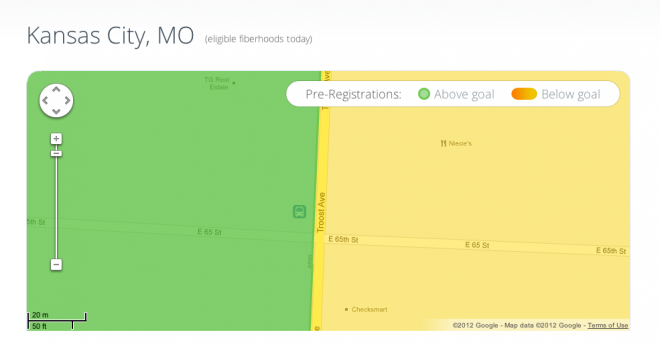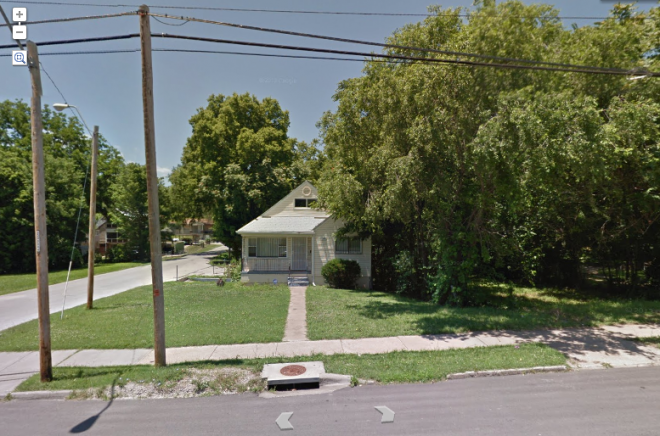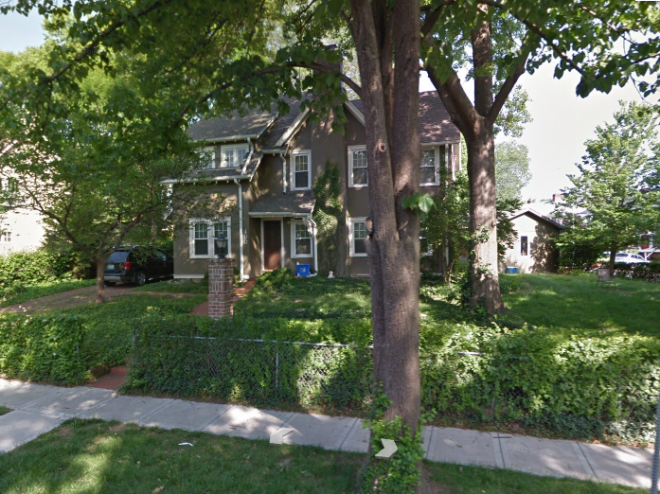
The Google Fiber project has stirred up lengthy-simmering emotions in Kansas City, Missouri, exactly where most of the neighborhoods that have pre-registered sufficient households to qualify for the service lie on the city’s far more affluent west side. Screenshot taken about noon Friday. Image: Google
Two days ahead of the deadline to get neighborhoods signed up, Google’s work to bring ultra-high-speed internet to a key American city could finish up reinforcing the digital divide.
When Google Fiber launched final month, the announcement of the service came with the caveat that to get the super-rapidly 1 gigabit broadband hookups, neighborhoods would have to pre-register a certain percentage of households for the service. The deadline for pre-registrations is Sunday at midnight.
Google has a map publicly tracking which neighborhoods meet the goal. As of Friday afternoon, Kansas City, Missouri, looks divided pretty much straight down the middle. On the western half of the city, nearly all neighborhoods have turned green, indicating they’ve met the goal. To the east, most are still yellow, which means they haven’t met the goal. Proper down the middle amongst the two halves runs Troost Avenue, the city’s historical socioeconomic and racial dividing line. Based on the map generated by the signup data, Google’s project is the most recent to fall short of bridging that gap.
“The white, affluent neighborhoods qualified and the primarily black, lower-income neighborhoods didn’t,” says Michael Liimatta, who runs a Kansas City nonprofit that functions to bring broadband access to low-income residents. Liimatta’s group, Connect for Excellent, focused on finding one particular of the poorest neighborhoods in Kansas City, Kansas, certified. They succeeded thanks to heavy campaigning and door-to-door efforts, he says.
Google did not go into Kansas City blind to the concern of the digital divide, says business spokeswoman Jenna Wandres. It has 60 representatives on the streets trying to convince folks with out world wide web access of the positive aspects of finding their houses online, Wandres says. (That number will go up to about 100 for this final weekend, she says.) But the method is a challenge, with common conversations lasting about 25 minutes per resident. Just before coming into Kansas City, Wandres says Google did a survey that located about 25 percent of residents didn’t have world wide web access at house. Although affordability is one part of the equation, she says Google identified another factor maintaining people offline was relevance. “They don’t believe they need to have it,” Wandres says. “They don’t see why.”

Troost Avenue is Kansas City, Missouri’s historical dividing line between wealthy and poor, white and black. Image: Google
A week ago, Google successfully lowered the minimum number of households needed for qualification for about a single-third of Kansas City’s neighborhoods after complaints from residents. The organization mentioned in a blog post that it had overestimated the quantity of residents in individuals neighborhoods in component by miscounting vacant lots and abandoned properties. The adjusted count indicates fewer households now want to pre-register in 73 neighborhoods. But that lower threshold hasn’t helped in many neighborhoods, according to Google’s map, at least not however.
The company says its pre-registration model aids it hold construction fees down by only bringing the service to places displaying demand. Wandres says these savings get passed on to customers, who will be capable to get a connection the firm is calling 100 occasions quicker than the average broadband connection, but for about the very same price tag – about $ 70 per month. Without having the efficiencies developed by not digging trenches and laying down fiber till demand reaches a crucial mass, Wandres says Google wouldn’t be in a position to supply its totally free service at all. She points to the totally free service as a clear sign of Google’s commitment to web access for absolutely everyone.
But Liimatta says the pre-registration method itself set a high bar for those already on the wrong side of the digital divide. To pre-register, residents required to be willing to pony up $ 10. They also necessary a credit or debit card, a Google Wallet account, and a Gmail account, which are tougher to come by if you in no way had web access in the 1st location. “Many don’t even have bank accounts,” Liimatta says. “That’s why there are so several verify-cashing places out there.”
Wandres says Google’s field representatives have 3G-enabled Chromebooks to aid get people signed up. She says Google will also accept a pre-paid debit card.
The lowest tier of service provided by Google Fiber guarantees a totally free broadband connection for at least seven years, even though consumers need to nonetheless come up with a $ 300 startup fee (which Google says covers its construction expenses). Google has also promised to provide broadband for cost-free to public institutions such as schools. The catch: The neighborhoods surrounding the schools want to reach the pre-registration purpose to get Google’s fiber unspooled to the spot in the 1st spot.

A house across from the Genesis School in a neighborhood east of Troost Avenue nevertheless far from its pre-registration purpose to get Google Fiber. Image: Google Street View
Take for instance the Genesis School, a public school for kindergarten through eighth grade in a neighborhood effectively east of Troost Avenue designated by Google Fiber as Vineyard Northwest. According to the Google Fiber site, Vineyard Northwest has 12 pre-registrations as of Friday afternoon. The neighborhood demands 37 a lot more for the Genesis School to get a free connection. Average listing value for a residence in the ZIP code that contains Vineyard Northwest and the Genesis School: about $ 35,000, according to true estate internet site Trulia.

A home close to Border Star Montessori School in a neighborhood west of Troost Avenue that will acquiring Google Fiber, ranks fourth out of 128 Kansas City, Missouri, neighborhoods in pre-registration rates. Image: Google Street View
West of Troost Avenue, Border Star Montessori School in the Wornall Homestead neighborhood will be acquiring a cost-free Google Fiber connection thanks to the 175 residents who put the neighborhood above the preregistration threshold several instances more than. Average house listing price tag in that zip code: $ 398,000, once again according to Trulia.
Rick Chambers, executive director of the Center Education Foundation, which raises cash for a school district that consists of numerous students east of Troost Avenue, has organized a pavement-pounding work to get poorer neighborhoods pre-registered. He says Google has supported his campaign even although individuals neighborhoods won’t probably be profitable for the firm, because most residents who sign up will decide on the free of charge service. Still, he says the most current gulf that’s opened along Troost Avenue has stirred up old emotions with deep roots in the city’s segregated background.
“The difficult portion is there has been a digital divide before Google got here. They didn’t produce this,” Chambers says. “But in their attempt to bridge it, they may possibly finish up widening it.”








